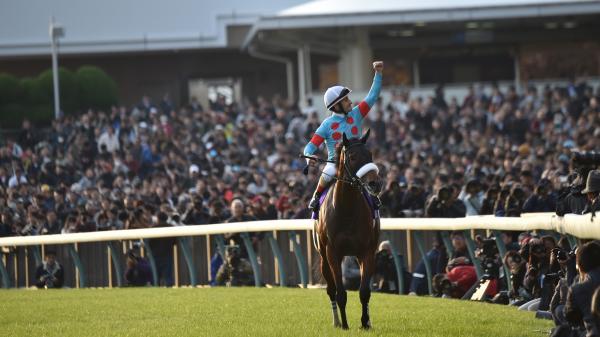On Nov. 1, the $7 million Longines Breeders’ Cup Classic was held at Del Mar, and history was made as Forever Young became the first Japanese-bred and -based horse to win North America’s richest race, defeating the 2024 Classic winner Sierra Leone by a half-length.
The Breeders’ Cup is the premier international horse racing event held in the U.S., bringing together runners from a variety of countries. Coming up Sunday, Nov. 30, Japan’s own international showcase, the Japan Cup, will be held at Tokyo Racecourse. It’s an annual high point on Japan’s racing calendar, much as the Breeders’ Cup is here – and for the first time, America’s Best Racing will be on site to cover the race and the entire event. Here’s what to know about the Japan Cup:
The race:
The Japan Cup is held on turf at a distance of 2,400 meters, or about 1 ½ miles. It boasts a purse comparable to the Breeders’ Cup Classic, with about 1.09 billion yen equaling about $7.2 million.
The race was created in 1981, three years before the first Breeders’ Cup event, by the Japan Racing Association. It was designed to attract international competition, with invitations extended to winners of prestigious races in other countries, and the first winner came from the U.S. Mairzy Doates, a mare that had won stakes in both New York and California, scored under jockey Cash Asmussen, the older brother of all-time leading North American trainer Steve Asmussen.
Foreign-based runners won nine of the first 11 Japan Cups, but the ratio of native Japanese winners vs. international invaders began to level off in the 1990s, and by the mid-2000s horses from the home country took over. There has not been an international winner of the Japan Cup since 2005 – Japanese horses have won 19 in a row!
The runners:
In recent years especially, there have not been a lot of foreign shippers racing in the Japan Cup, and that will be the case again in 2025. However, the one overseas runner expected to compete could very well be the race favorite: top-level European horse Calandagan.
Calandagan enters the Japan Cup off three consecutive Group 1 victories in England and France, and just last week he was named Cartier Horse of the Year – Europe’s best racehorse for 2025. Two of Calandagan’s Group 1 wins qualified him for a bonus of $3 million if he wins the Japan Cup in addition to the first-place purse of about $3.3 million, which is a part of an incentive program by Japan Racing Association to draw more international competition.
All of the other entrants for this year’s Japan Cup save one were bred in the host country – the exception is French-bred Shin Emperor. That colt has done most of his racing in Japan with several international starts, and he’s owned and trained by the same team that campaigns Forever Young – owner Susumu Fujita and trainer Yoshito Yahagi. Shin Emperor finished in a dead heat for second last year in the Japan Cup with Durezza, both only a neck behind the winner. These horses are both projected to start Sunday.
The track:
Tokyo Racecourse is the equivalent of Churchill Downs in Japan. The venue, located in the western suburbs of Tokyo and easily accessible via public transit, opened in 1933. In addition to the Japan Cup, Tokyo Racecourse hosts the Tokyo Yushun, aka the Japanese Derby, and several other internationally prestigious races.
It’s a state-of-the-art facility featuring turf, dirt, and jumps (steeplechase) courses and a video screen that’s approximately 8,000-square feet. The track presents as a very family-friendly venue, with a Kid’s Garden section in the infield including several rides, shows, and a playground. Just under 80,000 fans attended last year’s Japan Cup, well under its listed capacity of an incredible 223,000. The record crowd for a Japan Cup was set in 1995 at 187,524.
The weekend:
The entire weekend at Tokyo Racecourse topped by the Japan Cup is one of Japan’s most anticipated and exciting sporting events. On Saturday, Nov. 29, the Japan Road to the Kentucky Derby Presented by Woodford Reserve will kick off at Tokyo with a qualifying race. The Cattleya Stakes, held on dirt, offers qualifying points to the 2026 Derby at Churchill Downs to the top five finishers on a 10-5-3-2-1 scale. The best horse to win the Cattleya and then come to the U.S. was 2015 victor Lani, who ran ninth in the 2016 Derby, fifth in the Preakness Stakes, and then third in the Belmont Stakes.
Other big races are on the schedule, and with a crowd of around 75,000-80,000, the atmosphere promises to be electric.
Where to watch:
Viewers in the U.S. can watch the Japan Cup live for free on FanDuel TV if that network is part of the cable package. The Japan Cup has a post time of approximately 3:40 p.m. local time, which will be 14 hours ahead of the U.S. Eastern time zone (1:40 a.m. Sunday) and 17 hours ahead of U.S. Pacific time zone (10:40 p.m. Saturday).
How to follow:
As mentioned, America’s Best Racing will be on site at Tokyo Racecourse and also filming around the track to highlight popular attractions for visiting fans. We’ll have a team arriving on Thursday, Nov. 27 with plans to provide U.S. fans with an engaging and fun series of vignettes capturing the thrill of horse racing in Japan and how passionate its fan base is.
Follow America’s Best Racing’s TikTok and Instagram accounts for complete coverage, and videos will also be posted on our Facebook and X accounts.
Get ready to experience an exciting and memorable 2025 Japan Cup!


AloJapan.com